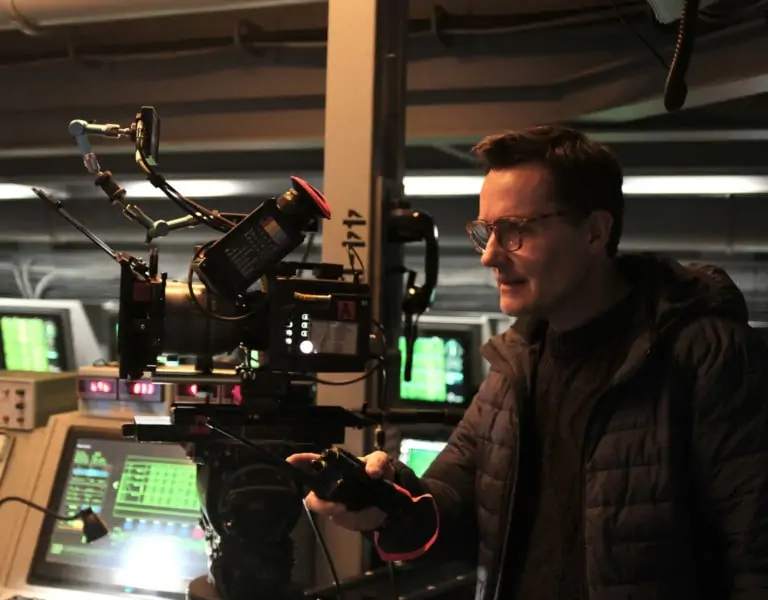Purple Reign
It’s the low-budget romance that fought off competition from the Russo Brothers’ $200 million behemoth, The Gray Man, to be crowned Netflix’s most-watched film of the summer – and one of its most successful of all time. Delve into Purple Hearts’ creative use of colour with cinematographer Matt Sakatani Roe.
“It was an opportunity to have broken, flawed characters and find ways to document their journey.”
Matt Sakatani Roe remembers being captivated by Purple Hearts as soon as he read the script. What the cinematographer possibly didn’t expect, however, was for hundreds of millions of viewers to be equally transfixed by the Netflix original, which joined the esteemed ranks of the platform’s all-time top 10 films this month. The marriage of convenience between an aspiring singer and a Marine, each with financial woes, chalked up over 228 million viewing hours in its first 28 days – a feat not to be sniffed at.
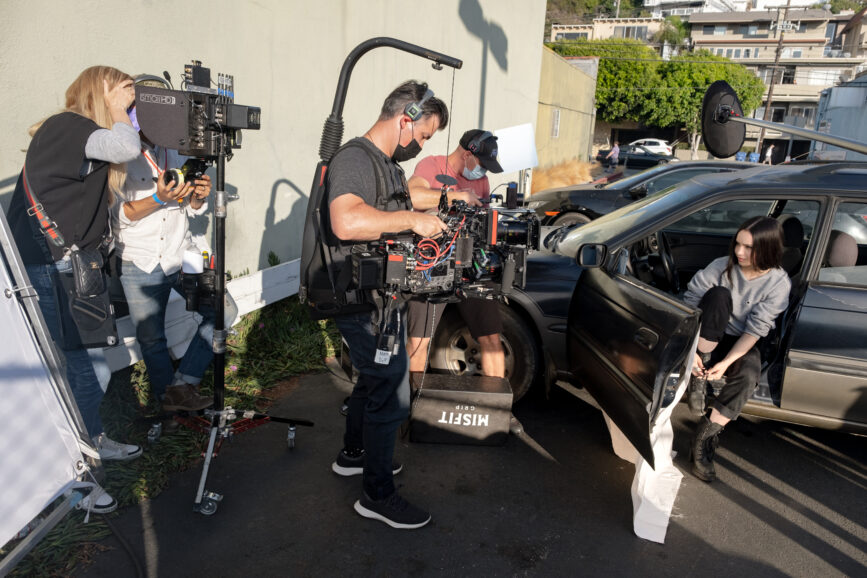
Alabama-born Roe’s own love story with cinematography was jump-started by his move to Los Angeles, where he interned for director Mark Pellington. Surprisingly, it was being asked to shoot a video of Pellington’s daughter’s fifth birthday party that earned him his big break.
“He wanted something simple, but told me to do whatever I want,” he recalls, “so I turned it into Darren Aronofsky’s The Wrestler, following around a five-year-old girl searching for her dad. He said he screened it for the family after I made it. His mother-in-law hated it, his daughter cried, but he loved it! And that got me a job shooting a music video for him.” It also led to Roe lensing his first feature film, Pellington’s Nostalgia.

It was through director Elizabeth Allen Rosenbaum, his close collaborator, that Roe joined Purple Hearts. The pair were in post on Disney+ movie musical Sneakerella when Rosenbaum sent him the script. “It was like the dream project, with people that had problems and observing them – that’s what I’m really interested in,” he adds.
Taking a handheld approach was a tenet of Roe’s filmic philosophy for Purple Hearts. “The last couple of shows we had done had that composed look,” he explains. “This time, we knew we wanted to be very subjective with the camera work and find ways to interact with and place the audience within the scene – sometimes almost inside the conflict that the characters were having.”

EMOTIONAL (DIS)CONNECTIONS
In prep, Roe took inspiration from Sean Bobbitt BSC’s work on 2012’s The Place Beyond the Pines, noting his influential camera techniques and the film’s colour palette, as well as his evolving lensing of the characters. “That was an idea I tried to implement in Purple Hearts because it’s a story of conflicting emotions,” he says. “I came up with the idea to visually fragment each character, both metaphorically and through lighting design. When you meet the characters in act one’s bar sequence, you have red and blue – the two colours that make purple – trying to create a dynamic space that visually echoes the characters’ internal states. Cassie (Sofia Carson) is broken inside and has conflicted emotions, and it’s the same with Luke (Nicholas Galitzine). As they came together, I wanted the conflicting multiple colour spectrum to form into a continuous colour spectrum of natural sunlight.

“Throughout the second into the third act, the characters conceal themselves from sunlight up until they recognise that there is a human connection between the two of them. As that spark glows, we start to slowly introduce full spectrum continuous lighting. So, their blinds open up a little bit more in the scenes that subsequently lead to their main connections. It ultimately culminates at the very end when Cassie is on the Hollywood Bowl stage, realises that she is in love with Luke and feels the warm sunlight, and goes to the scene with the court martial at the gate. That is the first time that both characters really bathe in warm continuous full spectrum sunlight.”
Roe’s camera package comprised the original Sony Venices with Rialtos and Cooke S7 Primes. The Venice 2 was released during production and some of the pick-ups were shot with it. “We primarily shot from a 2 to a 2.8 to a 4 at times, depending on the emotional response of the character and the fall-off we were looking for,” he adds. “I also used a Tiffen Black Satin 1/8 or 1/4 on everything to let the highlights have a little halation, like in a film print.”

MUSIC AND MOVEMENT
Principal photography took place from August to October 2021 across California, including Oceanside and the city’s Marine Corps Base Camp Pendleton. Some of the most exciting – and challenging – shoots were at the music venues where budding star Cassie plays with her band, The Loyal. The soundtrack includes four original songs, as well as rock-infused covers of ‘Sweet Caroline’ and ‘Feel It Still’.
“Shooting each musical number was a monumental task,” Roe recalls. “Each had its own distinct colour palette that [gaffer] Blake Farmer and I designed. He’s the real hero, visualising light placement and coming up with lighting programmes on his lunch break.
“We had three songs at a bar which each needed different looks. We approached the first performance with long, unbroken takes, because we wanted to show the audience that Sofia was credible as the character of Cassie, and to let everyone realise that this performer has the potential to get where she goes at the end of the film.”
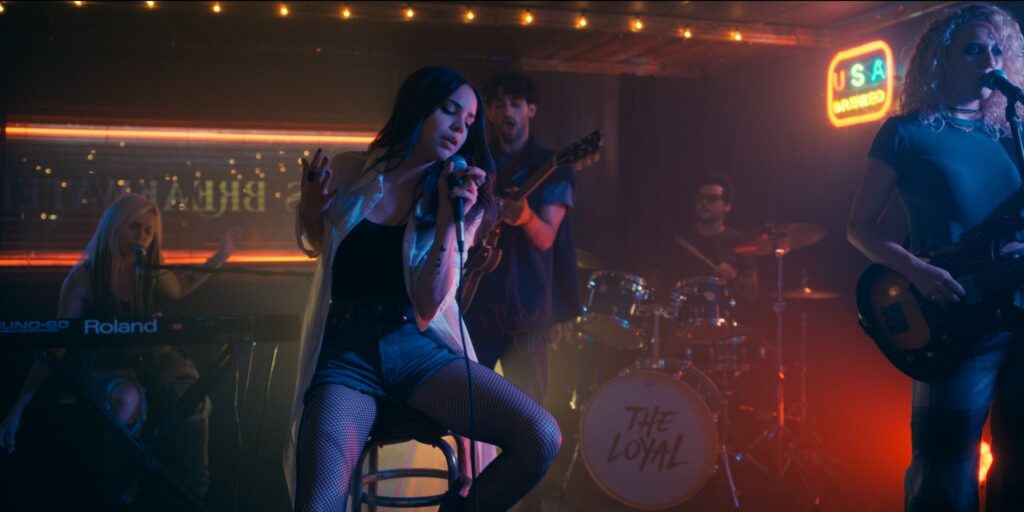
As her star soars, Cassie and The Loyal perform at a buzzy music festival in Oceanside. The script called for a huge live event performance, causing a logistical headache for the crew during pre-production, especially given the COVID regulations at the time. But as luck would have it, the Nissan Super Girl Surf Pro festival was taking place in Oceanside during filming, giving Rosenbaum a canny idea.
“She reached out to the concert promoter to see if they would be open, and they gave Sofia the headlining concert timeslot for two nights in a row,” Roe explains. “So, she performed as Sofia Carson for her full set, then right when the lighting was right, she switched costumes and turned into Cassie from the movie. She played her song ‘Come Back Home’ until it got too dark.
“It turned out great as we had real fans and a very economical way of doing something like that. The only problem was, they didn’t have any lighting installed, so while we were in pre-production, the lighting and grip team had to stagger pre-rig to install all the lighting for a fairly large venue while we were somewhere else in California.”

Another pivotal concert scene near the film’s climax sees Cassie and her crew take to the storied stage at the Hollywood Bowl to support Florence + The Machine. Shooting here was “really fun”, Roe says, but complex. The south-facing venue meant that he and his crew had to find ways to work with light, so they used a grip cloud to effectively cover it. They also faced the rare Californian challenge of a lightning storm, meaning the first shoot got cancelled.
WALK-UP WOES
Cassie’s third-floor apartment was another a logistical headache. The lack of a lift meant gear had to be lugged up and down three flights of stairs and concealing crew when shooting 360 or 270 degrees proved tricky. However, its stunning beachside views meant shooting practically was preferred.
Farmer, along with key grip Jake Reeder, came up with a handy way of deploying window treatments from the roof, allowing the team to shoot any time of day desired. “They had a system of grids – black grid, grey grid, scrims, every flavour of diffusion imaginable – that we could roll through a scaffold or truss system above the house to drape the windows.” Their lighting kit for the apartment also included LiteGears, Astera tubes and PARs.
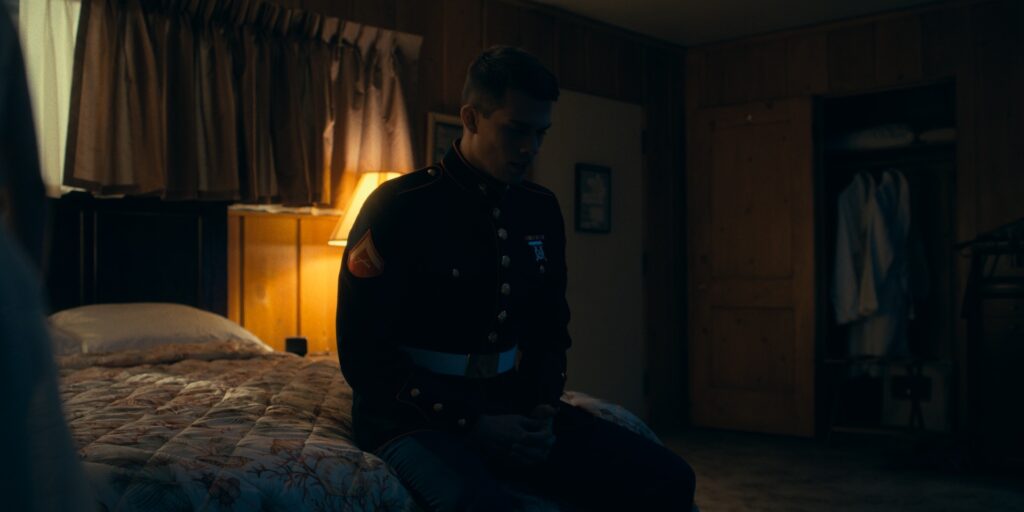
“There’s another fancy thing I’ve never really done before for our night-time scenes on the apartment,” Roe remembers. “We used HMIs through black grid cloth on Condors, creating a big black grid cloth chimera which coloured the light cool, but it was also such a weird quality that came out of a black grid cloth with an 18K HMI into the building. That was our flavour of moonlight where it had that cyan blue tint. You get a two-for-one with that tool because the kickback off the grid bounces lights behind it.”
The film’s use of colour was planned rigidly, with Roe citing Vittorio Storaro ASC AIC’s seminal books as influential. In prep, the team used colour theory and assigned ideas to colours to create a decision-making “bible” that could be referenced throughout production. Red became the characters’ obstacles, while blue represented their aspirations.
“Any time you saw red in the frame, it would represent the antagonist of a specific character. With Cassie, her main obstacle in the film was her blood [she has diabetes], so when she had an incident with her insulin levels, we tried to have a red bouquet in the background or a red pharmacy sign washing onto her. Then there was a song called Blue Side of the Sky, and we tried to frame characters below the horizon until the film really climaxed emotionally.”

Roe worked closely with “brilliant” production designer Kevin Bird and his team. One of Roe’s rituals during prep is to create a moodboard, which he sent to each department head and checked in on most mornings of filming. Together with Rosenbaum, they crafted Cassie’s apartment, quartering it off and creating layers using complementary colours and contrasts.
COLLABORATIVE APPROACH
The grade was completed by Company 3’s Bryan Smaller, with Jill Bogdanowicz devising the LUTs. Smaller, who joined the ranks of Forbes’ 30 Under 30 – Art and Style this year, helped Roe create HDR container LUTs that capped the nit range at 300 or 600 nits. “He made it feel like it was a bright space that could feel interesting in HDR, but not overly bright, and let that sit at a similar level to where SDR would be.”
Roe also credits DIT Michael Borenstein’s work. “We did on set colour dailies with secondaries, which was the first time I’ve ever done that,” he admits, “so dailies came out looking amazing. It really helped the post-production timeline. I don’t know how that man actually slept during production!”
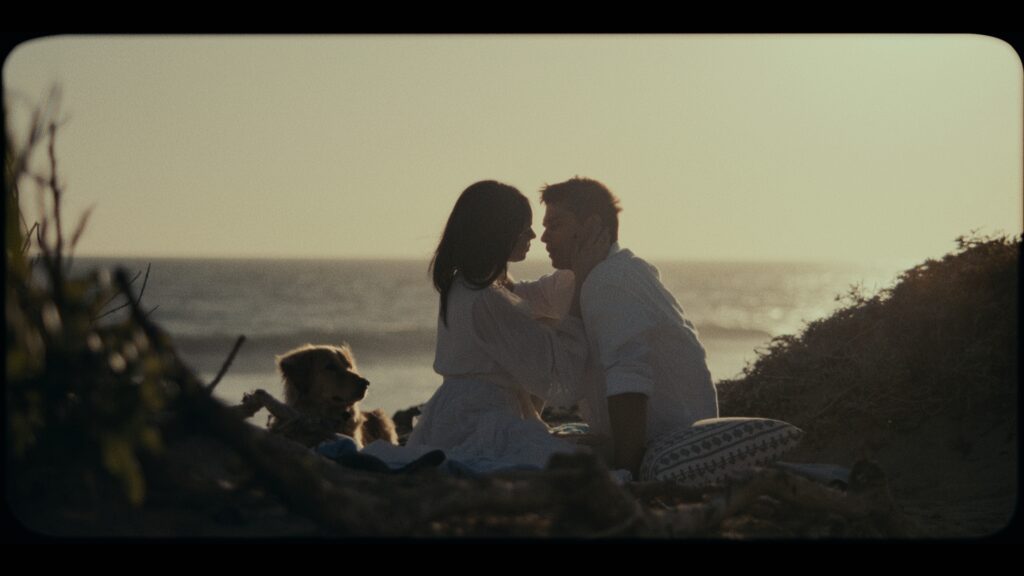
Another key collaborator for Roe was Dennis Noyes, A-camera and Steadicam operator. “We sat there and determined, what’s the best way to let the audience touch these characters in this moment?” he says. “Whether it was our rule of reaching out and being able to physically grab them, it told us if we were on the right lens when we wanted to invade their personal space as if one of the other characters inappropriately went into their circle of trust.”
One of Roe’s favourite experiences from shooting was working with his talented team to overcome any challenges they faced along the production journey. “One of the things I love most about being a cinematographer is logistical problem-solving,” he says with a smile. “I make the joke that I’m almost like a manager 70% of the time and an artist 30% of the time because I have to formulate my ideas and communicate them effectively to the rest of the crew, otherwise no-one really knows what’s going to happen or what’s next. I think having that communication is one of the best skills a cinematographer can have.”
It’s clear from the film’s runaway success that such communication has paid off. Its popularity has proved buoying for the cinematographer. “We work so hard on these films, and the fact that this one has registered an emotional connection and it’s placed in a Netflix top ten of all time means that all that hard work is acknowledged.”



